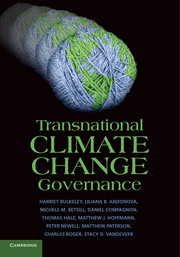Book contents
- Frontmatter
- Contents
- List of Figures and Tables
- Acknowledgements
- Acronyms and Abbreviations
- 1 Introducing Transnational Climate Change Governance
- 2 Mapping the World of Transnational Climate Change Governance
- 3 Theoretical Perspectives on Transnational Governance
- 4 Origins, Agency and the Forms of Transnational Climate Change Governance
- 5 Constructing Transnational Climate Change Governance Issues and Producing Governance Spaces
- 6 The Uneven Geography of Transnational Climate Change Governance
- 7 Understanding Authority and Legitimacy in Transnational Climate Change Governance
- 8 Making a Difference? Tracing the Effects and Effectiveness of Transnational Climate Change Governance
- 9 Conclusions – Looking Beyond Transnational Climate Change Governance
- References
- Index
7 - Understanding Authority and Legitimacy in Transnational Climate Change Governance
Published online by Cambridge University Press: 05 August 2014
- Frontmatter
- Contents
- List of Figures and Tables
- Acknowledgements
- Acronyms and Abbreviations
- 1 Introducing Transnational Climate Change Governance
- 2 Mapping the World of Transnational Climate Change Governance
- 3 Theoretical Perspectives on Transnational Governance
- 4 Origins, Agency and the Forms of Transnational Climate Change Governance
- 5 Constructing Transnational Climate Change Governance Issues and Producing Governance Spaces
- 6 The Uneven Geography of Transnational Climate Change Governance
- 7 Understanding Authority and Legitimacy in Transnational Climate Change Governance
- 8 Making a Difference? Tracing the Effects and Effectiveness of Transnational Climate Change Governance
- 9 Conclusions – Looking Beyond Transnational Climate Change Governance
- References
- Index
Summary
Introduction
One thing should already be clear from the preceding chapters: transnational climate governance is qualitatively different from the standard multilateral model that has characterised the last two decades of climate change governance. The multilateral model is a hierarchical one; it functions through the generally accepted legitimate authority of nation-states to act on issues that transcend borders. In the multilateral process, a legally binding global treaty engages all nation-states in a common (and hopefully enforceable) purpose. In theory, there is an assumption of smooth vertical development of policy that draws on the legitimate, traditional authority of nation-states, both in constructing the international treaty and formulating national regulations. International law translates to national regulation, which directs domestic actions at more local levels. Alternatives to the authority and legitimacy of the multilateral process are rarely considered quite simply because the global system has functioned through this process for over a century (Denemark & Hoffmann 2008) despite criticisms about the interests served by this system and whose order it seeks to preserve (Cox 1987; Murphy 1994; Cox & Sinclair 1996). The emergence and functioning of TCCG asks us to question and engage questions of authority and legitimacy with a more critical eye, to understand how, in Hajer’s (2003) words, we can have policy without a polity, or how, as Rosenau asks, a range of actors can govern without the legal authority to do so (Rosenau & Czempiel 1992).
- Type
- Chapter
- Information
- Transnational Climate Change Governance , pp. 134 - 157Publisher: Cambridge University PressPrint publication year: 2014



